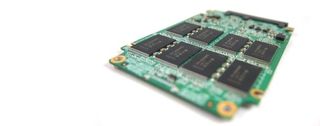Macronix self-healing SSDs last ten times longer

The one problem with solid state drives? They don't last. Non-volatile memory will generally just about last 10,000 read/write cycles before it gives up the ghost and falls over. Like, permanently. Dead. Norwegian Blue-style. Taiwan memory manufacturer, Macronix, though has come up with a neat solution which could extend that life to 100 million read/write cycles.
Good, eh?
Now, the principle they are using has been around for a while - essentially if you apply heat to the chips they reset and become usable again - but it's not been seen as an entirely practical application. Current thinking has meant the entire chip would need to be heated up to temperatures around the 250°C mark. For hours and hours.
Macronix have found however that by designing a flash memory chip housing onboard heaters they can anneal small groups of memory cells as and when needed. If you can apply a brief surge of heat to a small area that can return that section to a usable state again.
They are looking at heating up these tiny groups of memory cells to the tune of 800°C.
Luckily they don't think it's something they'll have to do all that often in order to hit the estimated 100 million cycles, and that it can be done on a sector by sector basis as and when it's needed.
Macronix anticipates that the whole thing can even be done when the device in question is inactive but still powered, giving the example of something that would then not drain a smartphone battery.
The biggest gaming news, reviews and hardware deals
Keep up to date with the most important stories and the best deals, as picked by the PC Gamer team.
Part of the team behind the Macronix discovery, Hang-Ting Lue, maintains that "we could have done this ten years ago." All it took was someone to look at the problem from a different angle to see how it could be implemented.
I wouldn't expect to see this plumbed into your next SSD purchase (unless you're not looking at buying a new drive for a decade or so), but fingers crossed these self-healing flash chips will find their way into our solid state drives soon.

Dave has been gaming since the days of Zaxxon and Lady Bug on the Colecovision, and code books for the Commodore Vic 20 (Death Race 2000!). He built his first gaming PC at the tender age of 16, and finally finished bug-fixing the Cyrix-based system around a year later. When he dropped it out of the window. He first started writing for Official PlayStation Magazine and Xbox World many decades ago, then moved onto PC Format full-time, then PC Gamer, TechRadar, and T3 among others. Now he's back, writing about the nightmarish graphics card market, CPUs with more cores than sense, gaming laptops hotter than the sun, and SSDs more capacious than a Cybertruck.
Most Popular






